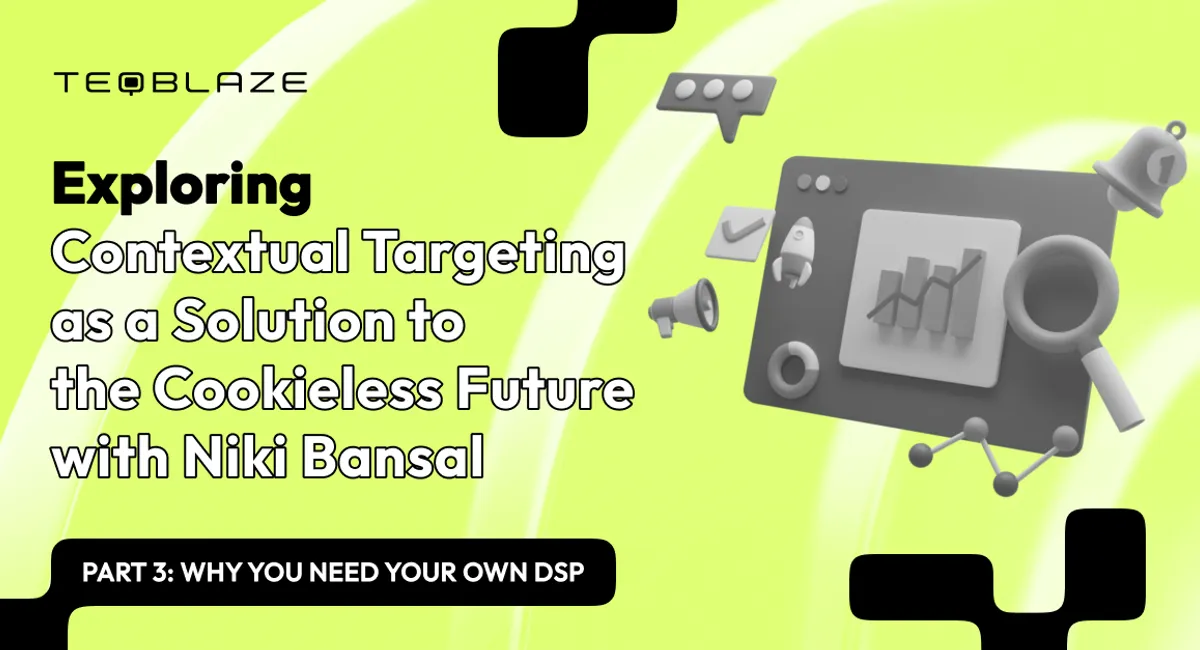While Google has delayed the complete phase-out of cookies to Q1 2025, it's still crucial to start preparing for a cookieless future now. This proactive approach will allow you to develop a solid strategy and navigate the upcoming changes smoothly.
In the first and second parts of interviews with Niki Bansal, we have discussed contextual targeting as the solution to the cookieless future. However, now we are going to dive deeper and find out why getting your own DSP is the way to meet the requirements of the era with no cookies.
* * *
Okay, here we go. Can you first explain what exactly a DSP is?
Niki: Sure. DSP stands for a demand-side platform, and this is a solution for programmatic ad buying, usually via real-time bidding auctions. Advertisers use DSPs to purchase the most relevant ad inventory automatically, and this is among the most significant benefits of such platforms. Instead of looking for the placement manually and hoping for the best, you just set up your campaign, and the rest is done by a DSP within a couple of seconds.
Sounds great. However, there are already some DSPs available on the market, including the SmartyAds ecosystem. Why do companies need to create their own DSPs?
Niki: Well, in general, building your own DSP is the way to gain full data ownership and complete control over the ad campaigns’ performance. You are in charge of everything, meaning that you can build the solution to meet your specific requirements and overcome your rivals. Everything depends on you — you identify your needs and then bring the corresponding solution to life under your own brand. This product is completely yours, and you can improve brand awareness and recognition with its help.
Besides, programmatic advertising is becoming more and more popular, and spending is increasing continuously. For instance, in 2017, it was around $187 billion. In 2021 — over $418 billion. By 2026, this rate is forecasted to exceed $724 billion.
For advertising agencies, building a DSP means an opportunity to remain competitive. And if we are talking about tech companies, creating a demand-side platform is the way for them to expand their product offerings and, again, attract more customers.
Another obvious reason for companies creating their own DSPs is that Google is steadily eliminating third-party cookies. Yes, they still exist, but in 2024, the process is going to be running in full, and it is crucial to get ready for this right now. Fewer and fewer websites are using cookies, so businesses are investing in developing DSP platforms that do not rely on this type of data, and this allows them to meet the needs of their customers.
Okay, then, what is the best approach in terms of DSP development? In-house, outsourcing, or anything else?
Niki: We have already prepared a detailed guide on the benefits and nuances of in-house, outsourcing, and white label approaches. Choosing among them can be challenging, but you should make a decision with your requirements and resources in mind.
For instance, if you want your solution to get to the market as quickly as possible, while cutting the expenses, white labeling is the best choice since you will only have to customize the selected platform. Actually, you can use it even without customization, meaning that your solution will enter the market extremely fast.
In turn, in-house development always means significant investments, both in terms of time and money. However, if you want to keep everything under control, in-house can be the way to go.
Each option has its specific pros and cons, so there is no universal answer to this question. Each of your decisions should be data-driven, and the DSP platform development is not an exception.
So, it is clear that companies should develop DSPs according to their specific requirements. But are there any features that are mandatory to implement?
Niki: In the coming cookieless future, an effective DSP should be able to operate without third-party data and be compliant with privacy regulations. Now, the contextual targeting feature, as well as identity solutions for hashing user data, is the most crucial thing. If you keep relying on cookies and traditional data management platforms, you lose regardless of your development approach.
Companies should implement artificial intelligence and machine learning algorithms to optimize the campaigns’ performance, ensure effective targeting, and help their users reach better results and reduce manual work.
Obviously, a DSP should also have reporting capabilities so that users will be able to track and analyze their campaigns in real-time.
Before deciding on the set of required features, I would also recommend companies to analyze their business needs as well as their competitors. This way, they can detect opportunities how to make their platforms stronger and more attractive to customers. This is actually an ongoing process, as keeping an eye on your rivals allows you to improve your product continuously and stay ahead.
And what about TeqBlaze? Are you ready for the cookieless future?
Niki: Sure thing. We have recently updated our customizable white-label DSP that combines contextual targeting features and the identity solution module for effective retargeting.
Thanks to this, for instance, the owners of white-label DSP solutions can ensure that their clients (demand partners) reach their audiences without relying on third-party cookies and compromising user privacy. Ads are aligned with the website’s content and users’ interests, so they do not look intrusive and have higher engagement rates.
The solution is fully ready, so businesses can start using it straight away, without investing in the time-consuming development process. When necessary, it can be customized, but this is also a pretty quick process. Compared with in-house or outsourcing, white labeling is the fastest method, and also the most cost-effective one.
Can you please tell me a bit more about TeqBlaze white-label DSP?
Niki: Going deeper into detail, our white-label platform is powered by machine-learning algorithms that allow effective campaign optimization. For example, if several sources keep delivering good results, the system will take it into account. Subsequently, it will give preference to such sources in the future, which will ensure stable ROI.
We have also implemented so-called smart alerts, so if any unexpected changes occur, advertisers can react promptly. As for price optimization, our platform allows KPI-driven campaigns, and the bidding strategies are adjusted dynamically.
To sum up, here, choosing SmartyAds AI-powered white label DSP platform is the way for companies to launch their services quickly while still meeting the needs of their users and getting ready for the cookieless era. We also offer support to customize the platform and add additional integrations (when necessary), so our customers do not need to have coding skills or a profound ad tech background. They get the required solution promptly, as well as the opportunity to stay ahead of their competitors.

 Kate Pavlova
Kate Pavlova





